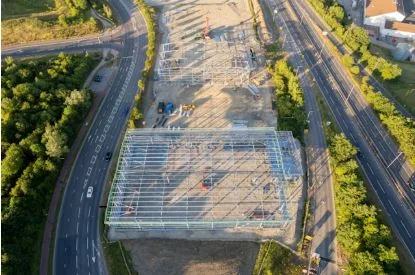7 Benefits of Steel Frame Construction for Commercial Buildings
Steel has revolutionized the way modern commercial buildings are designed and constructed. Its strength, flexibility, and durability make it an ideal material for everything from office towers and warehouses to shopping centers and schools. As the demand for sustainable, cost-effective, and high-performance construction continues to grow, steel frame construction is becoming the go-to solution for architects, builders, and property developers around the globe.
In this blog post, we’ll explore seven key benefits of steel frame construction for commercial buildings—and why it’s worth considering for your next project.
1. Exceptional Strength and Durability
Steel’s primary advantage lies in its incredible strength-to-weight ratio. Unlike wood or concrete, steel can support more weight without requiring bulky support structures. This means more open floor space, higher ceilings, and flexible layouts for modern commercial uses.
Additionally, steel is highly durable and resistant to many factors that commonly damage other materials. It does not warp, crack, or split, and it can withstand extreme environmental conditions including high winds, heavy snow, and seismic activity. For commercial buildings that are expected to endure years of use, steel offers long-term structural integrity with minimal maintenance.
2. Faster Construction Time
Time is money in commercial construction. The longer a building takes to complete, the greater the cost in terms of labor, equipment rentals, and delayed revenue. Steel frame construction significantly reduces the overall build time.
Steel components are prefabricated offsite under controlled conditions. This means they arrive at the job site ready to be assembled, eliminating the delays often caused by bad weather or inconsistent on-site craftsmanship. As a result, commercial steel buildings can go up in a fraction of the time it takes to build traditional wood or concrete structures.
This speed of construction not only reduces labor costs but also accelerates the time to occupancy, allowing businesses to operate and generate income sooner.
3. Flexibility in Design and Space Planning
One of the standout features of steel construction is design flexibility. Steel can span large distances without the need for interior support walls or columns, making it ideal for creating open, customizable interior layouts.
Whether you’re designing a retail space with a clear line of sight or an office building with evolving floor plans, steel frames allow for adaptability. Future renovations or expansions are also easier to implement, which is a major advantage for growing businesses that may need to scale their operations.
Incorporating elements like mezzanine floors, curtain walls, or skylights is much simpler when working with steel structures.
4. Cost-Effective in the Long Run
While the upfront cost of steel might be slightly higher than traditional materials, it often proves to be more cost-effective in the long run. Lower maintenance requirements, reduced construction time, and energy savings contribute to its overall economic efficiency.
Steel is also recyclable and reusable, which can reduce costs in future projects or renovations. In the case of dismantling, steel components can be sold or reused, helping offset initial expenses.
Additionally, insurance premiums for steel buildings are often lower due to their resistance to fire, pests, and weather damage. Over time, these savings can add up significantly, making steel an intelligent financial investment for commercial construction.
5. Sustainability and Eco-Friendliness
Sustainability is more than just a trend—it’s a necessity. Commercial building owners and developers are under increasing pressure to reduce environmental impact and meet green building standards.
Steel is one of the most eco-friendly building materials available. It’s 100% recyclable, and many steel products used in construction contain a high percentage of recycled content. Even during manufacturing, steel production has become cleaner and more efficient with reduced emissions and energy use.
Moreover, steel buildings often pair well with energy-efficient systems like solar panels, LED lighting, and advanced HVAC solutions. This synergy helps reduce a building’s carbon footprint and operating costs, making steel frame structures ideal for LEED certification and other sustainability benchmarks.
6. Fire and Pest Resistance
Safety is a top priority in commercial construction. Steel is non-combustible, which means it won’t ignite or contribute to the spread of fire. This inherent fire resistance enhances the safety of the building and its occupants and can lead to reduced fire-related insurance premiums.
In contrast to wood, steel is also impervious to pests like termites and rodents. These pests can cause extensive and costly damage to traditional structures, but steel eliminates this risk entirely.
Combined with its resistance to mold and mildew, steel ensures that the indoor environment remains healthier and more stable over time.
7. Ideal for Industrial and Large-Scale Projects
Steel frame construction is especially well-suited for large commercial and industrial applications due to its scalability and durability. From warehouses and factories to distribution centers and storage facilities, steel provides the strength and space flexibility that these types of buildings require.
Industrial buildings with light steel frame designs offer the additional advantage of being lightweight yet strong, making transportation and assembly easier while still supporting heavy equipment and large inventories. This allows businesses to optimize their space usage and streamline operations.
With large open spans and high ceiling clearances, steel-framed structures accommodate cranes, conveyors, and mezzanine levels with ease—ideal for manufacturers, logistics companies, and tech-driven enterprises.
Final Thoughts
Steel frame construction offers an impressive array of benefits for commercial buildings, from unmatched strength and speed to long-term sustainability and cost-efficiency. As businesses grow and building demands evolve, steel provides the flexibility and performance necessary to meet modern architectural challenges.
For those seeking efficient, safe, and environmentally responsible building solutions, steel frame construction is a compelling choice. Whether constructing a new office complex, warehouse, or retail facility, the advantages outlined above make a strong case for adopting steel in your next project.
By understanding the capabilities of this versatile material, developers and business owners can make informed decisions that serve their goals—both now and in the future.





